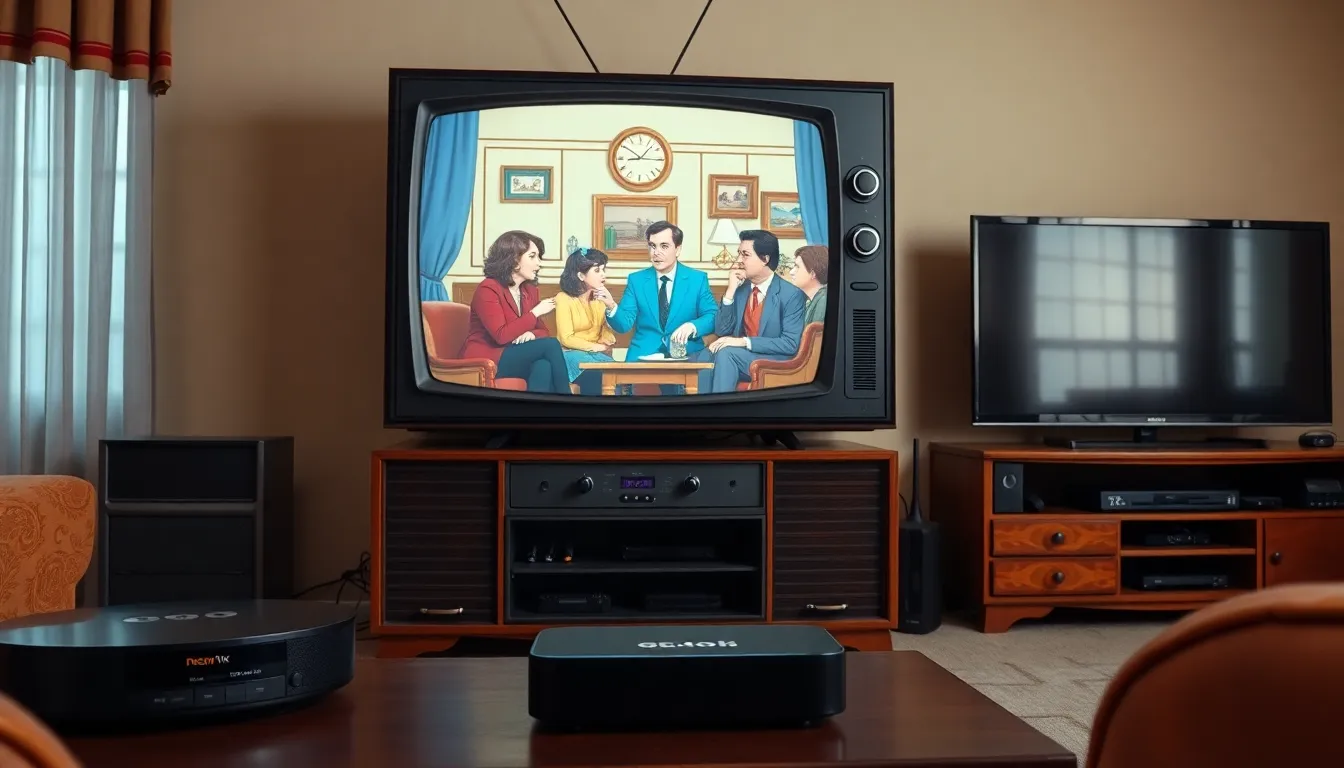Table of Contents
ToggleTV shows have become the heartbeat of modern entertainment, captivating audiences like never before. As binge-watching becomes a national pastime, trends in television evolve faster than you can say “next episode.” From gritty dramas that keep viewers on the edge of their seats to lighthearted comedies that bring laughter after a long day, there’s something for everyone.
Overview Of TV Show Trends
Television shows continue to shape modern entertainment landscapes. The trend of binge-watching affects viewing habits significantly. Streaming platforms like Netflix and Hulu lead in this shift, allowing audiences to enjoy entire seasons at once. Genre diversity expands, featuring everything from gripping thrillers to lighthearted sitcoms.
Viewers increasingly seek authenticity in storytelling. Documentaries and biopics gain popularity, reflecting real-life experiences and issues. Additionally, representation in casting matters more than ever, with shows highlighting different cultures and backgrounds.
Short-form content also emerges as a notable trend. Platforms like TikTok spark interest in quick, engaging series that fit into busy schedules. Social media engagement contributes to the success of these formats, fostering interactive fan communities.
Moreover, the revival of classic shows through reboots captures viewer nostalgia. These adaptations often bring fresh perspectives to beloved stories, appealing to both old fans and new audiences.
Data shows that over 70% of viewers prefer serialized shows, which create emotional connections with characters through ongoing narratives. Viewers also express interest in multi-season arcs, enhancing investment in plotlines.
Technological advancements impact storytelling as well. Virtual reality and augmented reality technologies expand creative possibilities for immersive experiences. Viewers embrace these innovations, pushing content creators to explore new avenues for engagement.
Overall, today’s TV shows reflect an evolving audience that demands quality, diversity, and innovative formats. Content production continuously adapts to satisfy these changing preferences.
Historical Context

Television has undergone significant changes since its inception, shaping the landscape of entertainment. This section examines the evolution of programming and the influence of technology on TV shows.
Evolution Of Television Programming
Television programming experienced several transformative phases. Early broadcasts featured limited genres such as variety shows and sitcoms, which drew large audiences. The introduction of cable expanded options, leading to niche channels that catered to specific interests. During the late 1990s and early 2000s, the rise of premium networks introduced complex storytelling in dramas. Nowadays, genres vary tremendously, embracing everything from gritty crime thrillers to uplifting reality shows. Today’s trends reflect a viewer base that values deep narratives and authentic storytelling, evidenced by data showing over 70% of viewers prefer serialized formats that foster emotional connections.
Impact Of Technology On TV Shows
Advancements in technology have reshaped how audiences consume television. Streaming services like Netflix and Hulu revolutionized viewing habits by allowing binge-watching of entire seasons. Consumers now expect immediate access to a broad selection of content. Additionally, high-definition and 4K streaming enhance visual experiences, making shows more immersive. Virtual and augmented reality innovations foster creative storytelling opportunities. Filmmakers utilize these technologies to engage audiences in new ways. Interactive formats enable viewers to participate in storylines, which aligns with the growing interest in fan engagement. The integration of social media further enhances audience interaction, driving trends surrounding real-time discussions during live broadcasts.
Current Trends In TV Shows
TV shows continue evolving, reflecting changes in audience preferences and technological advancements. These trends indicate a shift toward more engaging and inclusive content.
Streaming Services Dominance
Streaming services like Netflix and Hulu dominate viewership, offering vast libraries for binge-watching. Audiences embrace the flexibility of consuming entire seasons at their own pace. The convenience of these platforms leads to a notable increase in subscribers, with over 70% of viewers preferring streaming over traditional cable. Original programming from these services often garners critical acclaim, pushing conventional networks to adapt. With their algorithms personalizing recommendations, streaming platforms enhance viewer engagement significantly.
Diversity And Representation
Diversity in casting continues to gain momentum, reflecting a broader range of cultural narratives. Audiences increasingly demand authentic representation, prompting networks to prioritize inclusivity in storytelling. This trend not only resonates with viewers but also drives higher ratings for shows that highlight underrepresented voices. A growing number of productions now feature diverse casts and stories, creating more relatable content for global audiences. Companies are recognizing that investment in representation fosters loyalty among viewers, elevating shows’ popularity.
Shorter Series Formats
Shorter series formats are becoming more prevalent, catering to audiences with busy schedules. Many shows now consist of six to eight episodes, allowing for concise storytelling without filler. This trend aligns with the rise of short-form content, inspired by platforms like TikTok. By captivating viewers quickly, shorter series encourage binge-watching and keep audience interest high. Studies show that bite-sized storytelling can increase viewer retention and expand reach across demographics.
Audience Engagement Strategies
Audience engagement strategies are crucial for capturing viewer interest and maintaining loyalty. TV shows utilize various tactics to foster deeper connections with their audiences.
Social Media Interaction
Social media plays a significant role in enhancing viewer engagement. Platforms like Twitter and Instagram allow fans to share their thoughts in real-time during episodes. Viewers often participate in trending discussions, amplifying excitement around plot twists and character developments. Television networks frequently leverage these platforms to create polls and quizzes, inviting fans to express their opinions. Engaging content encourages users to connect directly with the show creators and cast, fostering a sense of community. According to data, over 65% of viewers acknowledge that social media interaction enhances their viewing experience, highlighting its importance in contemporary entertainment.
Viewer Participation
Viewer participation has evolved beyond passive watching. Audiences now engage with TV shows through interactive voting, influencing decisions about plot directions and character arcs on reality shows. Many programs introduce app-based voting systems, making participation accessible for viewers. Exclusive behind-the-scenes content often generates curiosity, prompting audiences to seek a deeper understanding of their favorite shows. Around 58% of viewers express interest in participating in live Q&A sessions with cast members, illustrating a desire for direct interaction. This active involvement fosters loyalty while making audiences feel integral to the show’s journey.
Future Predictions For TV Shows
Television shows will likely evolve further to meet shifting audience preferences and technological advancements. Trends in genre will reflect these changes.
Emerging Genres
Exploration of new genres sees unique narratives capturing viewer interest. Viewers increasingly gravitate towards hybrid genres, merging elements from drama, comedy, and thriller. Documentaries are gaining popularity, especially those highlighting cultural and social issues, appealing to audiences seeking authenticity. Audiences also show a strong preference for psychological thrillers, driving increased demand for suspenseful storytelling. Comedy-drama series engage viewers by blending humor with serious themes, reflecting contemporary societal challenges. The rise of fantasy series hints at a growing desire for escapism amid real-world stresses. Consequently, networks and streaming platforms are investing in projects that reflect these emerging trends.
Technological Innovations
Innovations in technology drastically change how viewers consume content. Interactive features in streaming services allow audiences to influence storylines in real time, enhancing engagement. Virtual reality offers immersive experiences that transport viewers into series worlds, creating deeper connections to characters. 4K content raises the bar for visual quality, making high-definition viewing increasingly standard. Additionally, integration of artificial intelligence enhances personalized recommendations, ensuring viewers discover shows that match their tastes. Mobile accessibility keeps viewers connected, enabling show consumption anywhere, anytime. These innovations pave the way for more engaging and immersive viewing experiences.
Television continues to adapt and thrive in a rapidly changing entertainment landscape. Audiences crave diverse storytelling and innovative formats that resonate with their experiences. As streaming services dominate viewership, the demand for authentic representation and engaging narratives remains strong.
Emerging trends like short-form content and interactive formats are reshaping how viewers connect with their favorite shows. The future of television is bright as it embraces new technologies and genres that cater to evolving preferences. With a commitment to quality and diversity, the industry is poised to captivate audiences for years to come.




